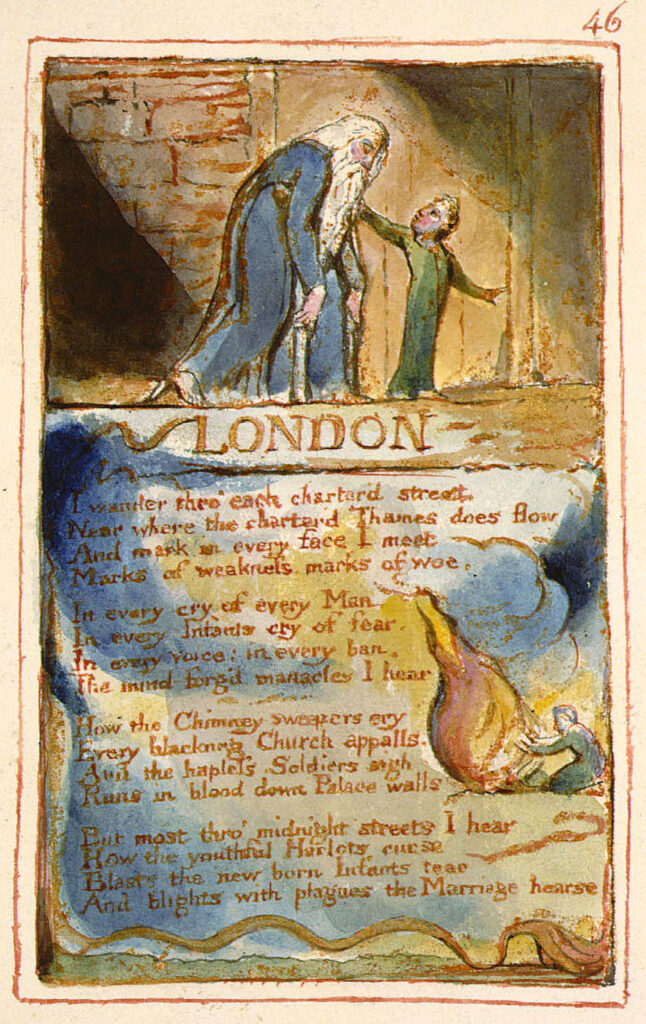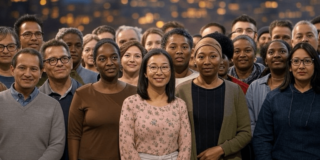
Introduction
In William Blake’s seminal poem “London,” published in his 1794 collection “Songs of Experience”, the poet wanders through the streets of the city, observing the pervasive suffering and oppression that mark the lives of its inhabitants. Amidst the cries of chimney-sweepers, the sighs of soldiers, and the curses of harlots, Blake identifies a profound and insidious form of bondage: “In every voice: in every ban, / The mind-forg’d manacles I hear.” This evocative phrase, “mind-forg’d manacles,” encapsulates the central theme of self-imposed restraints, chains not hammered in iron forges but forged in the anvil of the human mind. These manacles represent the internalised fears, doubts, and perceived limitations that individuals impose upon themselves, often leading them to abandon independent thought in favour of group belonging.
This paper explores the concept of mind-forg’d manacles as articulated in Blake’s “London,” extending it to a broader discussion of how people become prisoners to their own fears about their supposed limitations. It argues that these internal restraints drive individuals who fail to think for themselves to seek identity and security in groups, thereby fostering the development of hard-core right and left political factions and exacerbating societal polarisation. Drawing on literary analysis, psychological insights, sociological theories, historical examples, and contemporary case studies, the paper will demonstrate that while personal fears may initially paralyze action, it is the subsequent quest for group affiliation, rooted in these self-imposed limitations, that amplifies divisions, creating echo chambers of extremism more binding than solitary doubt. Ultimately, understanding and dismantling these mind-forg’d manacles is essential for fostering independent thinking and reducing the polar divides that fracture society.
The thesis of this paper is twofold: first, that fears of personal limitations, rooted in societal conditioning, past traumas and cognitive biases, create a self-perpetuating cycle of intellectual abdication; second, that this internal imprisonment propels individuals toward group identities, where the comfort of belonging outweighs critical inquiry, giving rise to the entrenched polarisation seen in hard-core right and left groups. By referencing Blake’s poem as a foundational text, we will unpack these ideas across various disciplines, aiming to provide a comprehensive examination that illuminates both the origins of such mental shackles and their role in societal discord.
Literary Analysis of Blake’s “London”
To fully appreciate the metaphor of mind-forg’d manacles, one must delve into the context and structure of Blake’s “London.” The poem is a stark critique of 18th-century industrial London, where rapid urbanisation and the Enclosure Acts had displaced rural populations, leading to widespread poverty, child labour, and moral decay. Blake, a visionary poet and artist influenced by Romanticism and radical politics, uses his verse to expose the systemic injustices of his time. The poem’s ABAB rhyme scheme and rhythmic tetrameter evoke the monotonous drudgery of city life, while its imagery paints a picture of universal woe. The key stanza reads:
“I wander thro’ each charter’d street,
Near where the charter’d Thames does flow.
And mark in every face I meet
Marks of weakness, marks of woe.
In every cry of every Man,
In every Infants cry of fear,
In every voice: in every ban,
The mind-forg’d manacles I hear.”
Here, “charter’d” suggests not just mapped or licensed streets and rivers, but a world commodified and controlled by institutional power. The repetition of “every” underscores the ubiquity of suffering, implying that no one escapes this condition. The “mind-forg’d manacles” are heard in “every ban,” which could refer to prohibitions, curses, or even marriage bans – symbolising societal restrictions that are internalised as personal truths.
Blake’s use of “forg’d” is deliberate; it evokes the blacksmith’s forge, a symbol of creation and industry, but twisted into self-oppression. Unlike physical manacles imposed by slave traders or jailers, these are self-made, born from the mind’s acquiescence to external narratives. In the poem, they manifest in the chimney-sweeper’s cry, which “appalls” the church (a pun on blackening its walls with soot while horrifying its hypocrisy); the soldier’s sigh, which runs in blood down palace walls, indicting monarchy; and the harlot’s curse, which blights the marriage hearse, critiquing institutionalised sexuality and family.
Scholars like David Erdman have interpreted this as Blake’s commentary on the French Revolution’s influence, where the English feared radical change, thus forging their own chains through complacency and fear. Northrop Frye, in “Fearful Symmetry”, argues that Blake’s manacles represent the Urizenic reason, Blake’s mythological figure of oppressive rationality, that limits human imagination. Thus, the poem posits that true oppression is not merely external but internalised, where individuals accept their “weakness” and “woe” as inevitable, thereby restraining their own potential for rebellion or transcendence.
This literary foundation sets the stage for understanding how, in real life, people forge similar manacles through fears of their limitations – be they intellectual, physical, social, or emotional. These fears convince individuals that they are incapable, unworthy, or doomed to failure, prompting them not to think independently but to seek solace in groups, where shared identities mask personal doubts and fuel polarisation between extremes like the hard-core right and left.
Psychological Dimensions of Self-Imposed Limitations
From a psychological perspective, mind-forg’d manacles can be understood as cognitive and emotional constructs that inhibit behaviour. Fears about supposed limitations often stem from early experiences, cognitive biases, and mental health issues, creating a prison of the mind that is self-reinforcing. Rather than fostering independent thought, these manacles drive individuals to conform to group norms, amplifying polarisation as people align with ideological tribes for a sense of belonging.
One key concept is “learned helplessness,” pioneered by psychologist Martin Seligman in the 1960s. In experiments with dogs subjected to inescapable shocks, the animals eventually stopped trying to escape even when opportunities arose. Applied to humans, this explains how repeated failures or traumas lead individuals to believe they lack control, forging manacles of passivity. For instance, a person who has faced repeated job rejections may internalise the belief “I’m not good enough,” restraining them from independent pursuits and pushing them toward groups that offer predefined identities and solutions.
Imposter syndrome, another psychological phenomenon, exemplifies this. Coined by Pauline Clance and Suzanne Imes in 1978, it describes high-achieving individuals who doubt their accomplishments and fear being exposed as frauds. This internal fear discourages solo endeavours; instead, affected individuals might join echo chambers where group validation substitutes for self-confidence. Studies, such as those in the “International Journal of Behavioural Science” , show that imposter syndrome affects up to 70% of people at some point, disproportionately women and minorities, highlighting how societal biases are internalised and drive group-seeking behaviour.
Cognitive biases like confirmation bias further strengthen these manacles. Individuals seek evidence that confirms their limitations (“See, I failed again”) while ignoring counterexamples, creating a feedback loop. Anxiety disorders amplify this; the fear of failure becomes so paralysing that inaction feels safer than risk, leading people to outsource thinking to groups. As Blake heard manacles in every voice, modern psychology hears them in the inner monologue of self-criticism, which often resolves into tribal affiliations where dissent is discouraged.
Historical figures illustrate this. Vincent van Gogh’s letters reveal profound self-doubt despite his genius, leading to isolation and tragedy. His manacles were mind-forg’d, pushing him away from independent expression toward fleeting group associations. Similarly, in literature, Hamlet’s soliloquy – “To be or not to be” – reveals paralysis from overthinking, a self-imposed restraint that mirrors how modern individuals, burdened by doubts, flock to polarised groups for decisiveness.
Thus, psychology reveals that fears of limitations create invisible chains, more binding because they are woven into the fabric of one’s identity, ultimately channelling personal insecurity into collective extremism.
Building on learned helplessness, consider the role of attribution theory. Fritz Heider’s work shows how people attribute failures to internal, stable factors (“I’m inherently bad at this”), forging durable manacles. Locus of control, per Julian Rotter, distinguishes internals (who believe in agency) from externals (who blame fate), but even internals can fall prey to fear-induced shifts, leading to group dependency.
Neuropsychology adds depth. The prefrontal cortex, responsible for decision-making, is inhibited by chronic stress hormones like cortisol, literally restraining action. Functional MRI (fMRI) studies show anxious individuals have hyperactive threat-detection circuits, perceiving limitations where none exist, prompting them to seek safety in ideological packs.
Case study: Procrastination, a modern epidemic. Timothy Pychyl’s research reveals it’s not laziness but emotion regulation failure, fears of imperfection lead to avoidance, manacles stronger than personal ambition, often resolved by joining groups that provide external motivation.
In child development, Carol Dweck’s growth mindset versus fixed mindset paradigm is crucial. Children praised for effort develop resilience, while those praised for intelligence forge manacles around risks, fearing to expose “limits,” setting the stage for lifelong group conformity.
Therapeutic interventions: ACT (Acceptance and Commitment Therapy) encourages defusion from thoughts, treating fears as passing clouds, not chains, to promote independent action over groupthink.
These expanded psychological insights further emphasise how deeply embedded these manacles are, operating at neurological, developmental, and behavioural levels, making them resilient to individual resolution and propelling people toward groups. The interplay between attribution styles and mindset theories illustrates a continuum where early experiences shape lifelong restraints, often without conscious awareness. For example, in educational settings, a fixed mindset can lead students to avoid challenging subjects, not due to lack of ability but fear of confirming inadequacy, perpetuating a cycle that external motivators like grades or teachers cannot fully break, thus encouraging affiliation with like-minded peers. Moreover, in clinical practice, therapies like ACT not only defuse thoughts but also promote values-based action, encouraging individuals to act despite fears, thereby weakening the manacles over time and reducing the pull toward polarised groups. This multifaceted view underscores how internal restraints adapt and evolve, turning personal doubts into societal divisions as individuals seek the illusion of strength in collectives. As these psychological mechanisms interlock, they form a robust barrier to independent thinking, where the mind becomes its own jailer, echoing Blake’s auditory imagery of clanking chains in every cry. Transitioning from individual psychology to broader social contexts, it becomes evident that these manacles are not forged in isolation but are reinforced by societal structures, amplifying the drive toward group identity and polarisation.
Sociological Reinforcement of Mind-Forg’d Manacles
Sociologically, mind-forg’d manacles are not merely individual but collectively forged through institutions, norms, and power structures. Pierre Bourdieu’s concept of “habitus” – internalised dispositions that guide behaviour – aligns closely with Blake’s idea. Habitus is the embodiment of social structures, where individuals accept class, gender, or racial limitations as natural, restraining independent thought and pushing them toward groups for identity, thus fuelling polarisation between hard-core right and left factions.
Education systems often forge these manacles. In “Pedagogy of the Oppressed”, Paulo Freire argues that “banking education” deposits knowledge into passive students, fostering a fear of critical thinking. Students internalise “I’m not smart enough to question,” becoming prisoners to perceived intellectual limits, seeking group affiliations that provide ready-made ideologies instead of self-censorship.
Media and culture perpetuate this. In consumer society, advertisements exploit fears of inadequacy, “You’re not complete without this product”, creating manacles of materialism. Social media amplifies comparison, leading to “fear of missing out” (FOMO), where users restrain themselves from authentic pursuits, chasing illusory ideals within polarised online communities.
Gender norms provide stark examples. Women historically internalised limitations like “I’m not suited for leadership,” as discussed in Simone de Beauvoir’s “The Second Sex”. This self-restraint drives affiliation with groups that reinforce or challenge these norms in extreme ways. For men, toxic masculinity forges manacles around emotional expression, leading to higher suicide rates – fears of vulnerability push them toward hard-core right groups emphasising traditional roles.
In racial contexts, WEB Du Bois’s “double consciousness” describes how African Americans internalise white gazes, forging manacles of self-doubt. During Jim Crow, internalised inferiority restrained aspirations, leading to fragmented group identities that polarised along radical lines.
Sociological manacles operate through hegemony, Antonio Gramsci’s term for consent to domination. People police their own thoughts, making independent inquiry redundant and group loyalty paramount, as seen in the rise of identity politics. Modern workplaces exemplify this. “Quiet quitting” arises from fears of overextension, where employees limit effort not due to personal conviction but internalised burnout fears, often aligning with union or anti-union groups for identity. Thus, sociology shows how society forges manacles collectively, rendering them more insidious and durable, channelling individual limitations into group polarisations.
Expanding on Bourdieu, consider intersectionality from Kimberlé Crenshaw. Overlapping oppressions (race, gender, class) compound manacles, making them multilayered. A Black woman might internalise limitations from multiple sources, restraining independent advocacy and driving her toward intersectional activist groups or conservative counterparts. Other concepts include:
- Globalisation: neoliberalism forges manacles of individualism, “Pull yourself up by bootstraps”, ignoring systemic barriers, leading to self-blame and subsequent rejection in favour of populist groups on the right or left.
- Education: Standardised testing reinforces hierarchies, students internalising “I’m a C-student,” limiting aspirations and encouraging clique formation that mirrors political divides.
- Media: Algorithmic echo chambers amplify fears, as in Eli Pariser’s “filter bubbles,” where users self-restrain exposure to challenging ideas, solidifying group identities.
- Gender: #HeForShe campaign addresses men’s manacles around feminism, fears of emasculation stronger than individual reflection, pushing toward anti-feminist groups.
- Racial: Colourism within communities forges internal divisions, restraining solidarity and fostering sub-groups that polarise broader discourse.
- Workplace: Glass ceiling is often self-imposed through “leaning out,” as Sheryl Sandberg notes, fears of work-life imbalance driving women toward feminist collectives or traditionalist ones.
These expansions reveal the layered nature of sociological manacles, where intersectional identities create compounded fears that intersect and reinforce each other. For instance, in globalised economies, neoliberal ideologies promote a meritocratic myth that blames personal failings for structural inequalities, leading individuals to internalise economic limitations as character flaws, only to rebel by joining extreme economic ideologies on the spectrum. In educational contexts, standardised testing not only ranks but socialises students into accepting those ranks as innate, curtailing ambitions before they form and seeding early group affiliations. Social media’s filter bubbles exacerbate this by curating content that confirms biases, creating echo chambers where alternative perspectives are feared rather than explored, entrenching left-right divides. Campaigns like #HeForShe demonstrate attempts to dismantle gender-specific manacles, but their success hinges on individuals confronting internalised norms, highlighting how societal change requires internal shifts away from group dependency. Colourism, as an intra-community phenomenon, shows how manacles can be forged within marginalised groups, dividing potential allies and weakening collective action against external oppressors, often leading to splintered political factions. In workplaces, the “leaning out” phenomenon illustrates how anticipated conflicts lead women to pre-emptively limit their trajectories, a restraint more subtle and pervasive than overt discrimination, pushing toward polarised advocacy groups.
Overall, these sociological dynamics ensure that manacles are reproduced across generations and institutions, making them a foundational element of social control and polarisation. This collective forging process bridges to historical contexts, where such internalised limitations have shaped the course of events, often through the rise of extreme group movements.
Mind-Forg’d Manacles in Medical Contexts and Racist Group Think
Extending the concept of mind-forg’d manacles to specific domains, we can examine how these self-imposed restraints manifest in medical contexts and contribute to racist group think, further illustrating the theme of individuals forsaking independent thought for group belonging. In medicine, fears of personal limitations, such as doubts about one’s expertise or ability to challenge established norms, forge manacles that discourage critical inquiry, leading professionals and patients alike to conform to prevailing paradigms, even when flawed. This internal bondage drives affiliation with medical “tribes,” where group consensus overrides evidence, polarising debates on treatments, vaccines, or healthcare policies.
For instance, during the COVID-19 pandemic, mind-forg’d manacles played a role in the spread of medical misinformation. Individuals burdened by fears of inadequacy in understanding complex science turned to anti-vax or alternative medicine groups for identity and certainty. These groups, often aligned with hard-core right ideologies sceptical of institutions, amplified distrust in mainstream medicine, creating echo chambers where independent verification was dismissed as betrayal. Similarly, in historical medical scandals like the Tuskegee Syphilis Study, internalised limitations among researchers, fears of questioning ethical norms, perpetuated racist practices, with group think justifying the exploitation of Black participants under the guise of scientific consensus.
Racist group think emerges as a particularly pernicious outcome of these manacles, where fears of social exclusion or personal vulnerability propel individuals into collectives that reinforce prejudicial beliefs. In racist ideologies, mind-forg’d manacles manifest as internalised notions of superiority or inferiority, restraining empathy and critical self-examination. People who perceive their own limitations, economic insecurity, cultural displacement or identity crises, seek belonging in white supremacist or ethnonationalist groups on the far right, where shared narratives of victimhood or dominance provide a false sense of empowerment. This group think stifles dissent, as members forge manacles around challenging racist dogma, fearing ostracism more than moral reckoning.
The intersection of medical and racist group think is evident in eugenics movements, where pseudo-scientific beliefs in racial hierarchies forged manacles that limited ethical scrutiny, leading to forced sterilisations and discriminatory policies. In contemporary terms, disparities in healthcare, such as higher maternal mortality rates among Black women, persist partly due to internalised biases among medical professionals, who conform to institutional group think rather than questioning systemic racism. Patients, too, may internalise limitations, avoiding care due to fears of discrimination, further entrenching divides.
Psychologically, this ties back to cognitive dissonance: confronting racism or medical errors requires dismantling personal manacles, but group belonging offers comfort in denial. Sociologically, it aligns with Du Bois’s double consciousness, where marginalised groups internalise oppression, while dominant groups forge manacles around privilege, resisting change. Historically, Nazi medical experiments exemplified extreme racist group think, where fears of professional failure drove adherence to genocidal ideologies.
To break these manacles, medical education must emphasise critical thinking and diversity training, while anti-racism efforts promote individual reflection over tribal loyalty. In Blakean terms, these contexts reveal how mind-forg’d manacles not only restrain but redirect human potential toward destructive collectives, underscoring the need for liberation to heal societal fractures. The mind-forg’d manacles in medical and racist group think highlights their role in perpetuating harmful polarisation, bridging psychological and sociological insights to underscore the broader implications for independent thought.
Conclusion
William Blake’s “London” endures as diagnosis of bondage, mind-forg’d manacles from fears imprisoning via group-seeking and polarisation. This paper explored origins, mechanisms, reinforcements, manifestations, applications, paths and affirming role in divides. Global challenges include climate, inequality, AI, dismantling imperative. Heeding Blake’s imagination we must forge the keys to independence. Revolution begins within, an unshackling for unity. As Blake might say, hear not manacles, but the symphony of independent minds.



